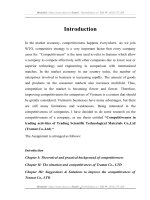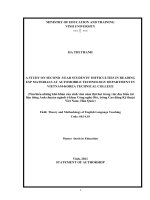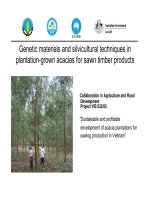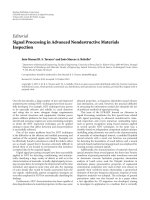researching in seperating biodegradeble materials
Bạn đang xem bản rút gọn của tài liệu. Xem và tải ngay bản đầy đủ của tài liệu tại đây (148.08 KB, 9 trang )
1
RESEARCHING IN SEPERATING BIODEGRADABLE MATERIALS FROM
MUNICIPAL SOLID WASTE BY HYDRAULIC POWER.
Dinh Trieu Vuong and Vo Dinh Long
Dinh Trieu Vuong is with Engineer of Environmental engineering.
Email:
Vo Dinh Long is with the Director of the Center for Environmental Resources
Research, Ho Chi Minh University of Industry
Email:
Abstract: Municipal Solid Waste (MSW) consists of a myriad of discards from
households, businesses, and institutions managed in common. Thus MSW is extremely
heterogeneous, seasonally variable, and differing in composition even among different
collection routes within a given municipality. The organic and inorganic fractions
consist in MSW very dissimilar problems, yet are received as a mixture in a single
waste stream. It is not difficult to see that the most biodegradable materials’ density is
higher than the water’s one and the most recyclable materials’ density is lower than
the water’s one. So, we can use water to separate MSW. To use water in separating
MSW, we need establish required data: flow rate, stuff rate, belt position, capacity
and water volume per one ton MSW. The researching results show that when we put
MSW into water, MSW is separated to 3 part:
- The heavy components that sunk to the bottom and were subsequently separated
from the organic stream include ferrous metals, non-ferrous metals, glass and other
inert materials.
- The biodegradable materials suspend in water.
- The light waste such as nylon bags, plastic bottles.. float on water surface.
Besides, calculating also shows that extra advantages of this method about
economic value, efficiency and environmental value.
Keywords: Seperating MSW by hydraulic power, biodegradable materials,
Municipal Solid Waste.
2
1. Introduction
Growing of scientific and technical help human’s quality life enhanced. Thus,
population is increasingly incremental, leading to increase the amount of Municipal
Solid Waste (MSW). Besides that is exhausting the reserve of natural resouces,
especialy is non-renewable resources as petroleum, coal... If this continues to happen
in the future, people will no longer use mineral and the earth will be filled with waste.
Therefore, in a few decades ago, many parts of the world were intrested in re-
ultilization of waste, especially is MSW with many component can utilize as plastic,
metal, glass, organic matter... Recycling or reusing MSW help reduce production costs
for manufacturing companies, increase income for waste treatment companies and
reduce pressure on natural resources is getting exhausted.
The most important stage in the full technology utilization of solid waste is the
seperation. In the past, the seperation is mainly done by hand. Nowadays, many
technology automatically are used, for example riddle, magnetic field, wind.... To be
able to apply these technologies, MSW must be removed biodegradable materials to
reduce the MSW’s moister. In many countris around the world, applying these
technologies is quite easy because MSW is serperated at source by people. However,
in the other countries, as Viet Nam, MSW isn’t seperated at source, so applying these
technology is difficult. Although, some waste treatment companies use labor to
seperate MSW, this doesn’t bring economic benefits, so many companies don’t apply .
Therefore, researching to create a device which can seperate biodegrades
materials from MSW will contribute solving that problem. Since then, many waste
treatment companies at Viet Nam as well as other countries on the world can apply in
the full technology utilization of MSW. This brings many benefits in economics,
social and especially environment.
2. Theoritical basis
The density of different MSWs is different. We determined some components
of MSW. The biodegradable materials’ density is about 1050 kg/m
3
and the nylon
bags’ density is about 160 kg/m
3
. This show that, we can separate MSW depend on
their density difference. We used water as an agent to separate MSW. When we put
MSW into the uninterrupted flow, MSW is separated to 3 parts:
3
- Part 1 – The part floats on the water surface: include mainly components may be
recycled for example plastic bottle, nylon bags…
- Part 2 – The part suspends in the water which include biodegradable materials for
example surplus foods, papers, garden wastes…
- Part 3 – The part sunk to the bottom which include heavy components for example
sand, stone, metal pieces, glass…
3. Experiments and Results.
We have conducted experiments as the diagram in Figure 1.
Figure 1: The research propress.
Invest components and
properties of MSW
Build Laboratory scale
model
Operate the model to
discover parameters
Flow rate
Input speed
Water cycle
change
Data processing by Excel,
Stat Graphics software
Belt placement
Basic parameters to
build the system
4
Structures of the model are shown in Figure 2.
Figure 2: The structure of the seperating biodegradable materials from
municipal solid waste by hydraulic power model.
The structure of the modle has three mainly parts:
- The water tank: to separate the biodegradable material: this tank made of glass, so
we can see its inside. Its size include length x width x height is 2 x 0,9 x 0,3 m.
Suppling ion to tank is carried out by a pump 1Hp. The water is distributed by eight
ejector. Every ejector’s diameter is 21mm. The water is circulated reapeatly.
- The belt: there are 3 belts built up in the tank: one belt is used to collect the part
float on the water surface, one belt is used to collect the suspended part and the
other one is used to collect the sunked part.
- The input system: include a rotary drum to drown MSW and a loading bin. That
drum is assembled on the water surface and the bin is assembled on the drum.
- The bracket: to carry the tank and the other things assembled in that.
Experimental determination of flow rate
5
Figure 3: Chart of effective separation depend on flow rate.
Depending that chart, inferred flow rate is effective from 0,12 (m/s). We
selected 0,2 (m/s) for follow experiments
Through above experiment we also draw a conclusion: effective classification
doesn’t depend on the flow rate, but depend on property flow, which have to be
laminar flow. The flow rate affects only the yield separation.
Experimental determination of input speed
Input speed, which is the weight of MSW input per once, affect directly
effective system separation. If we put a lot of MSW into the water, MSW’s
components will mix, therefore effective separation of biodegradable materials will
low because the first belt will collect them before they can arrive to the second belt.
Effectiveness (%)
Flow rate(m/s)









